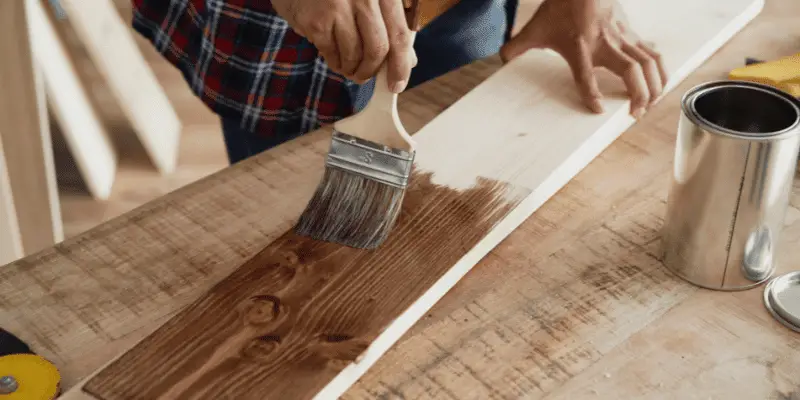For staining wood, it is recommended to apply two coats of stain.
Understanding The Staining Process
Understanding the staining process involves knowing how many coats of stain are required for wood. By determining the number of coats needed, you can achieve the desired color and depth for your project. Achieving the perfect finish involves patience, skill, and the right application technique.
Staining wood is a popular technique used to enhance the natural beauty of the material while protecting it from damage. Whether you want to stain a piece of furniture or a wooden deck, it’s essential to understand the staining process to achieve the desired results.
Here, we will explore the factors to consider before staining, types of wood suitable for staining, and the importance of surface preparation.
Factors To Consider Before Staining:
- Wood species: Different types of wood absorb stain differently, so it’s important to select the right wood for your project. Some woods, like pine and oak, are commonly used for staining due to their beautiful, visible grain patterns.
- Age and condition of the wood: Older wood may have a different structure, making it more challenging to achieve an even stain. Additionally, if the wood has previous finishes, it needs to be stripped or sanded before staining.
- Desired color: Think about the color you want to achieve with the stain. Lighter stains allow more of the wood grain to show through, while darker stains provide a rich, deep hue.
- Environmental conditions: The climate you live in and the environment where the wood will be placed can impact the staining process. Consider factors like humidity and temperature, as they can affect the stain’s drying time and overall effectiveness.
Types Of Wood Suitable For Staining:
- Hardwoods: Hardwoods, such as oak, maple, and cherry, are known for their dense grain patterns and ability to take on a stain beautifully. Their natural beauty is enhanced by the stain, giving them a rich and elegant appearance.
- Softwoods: Softwoods like pine, cedar, and fir are also suitable for staining. However, due to their more porous nature, they may require extra attention during the staining process to achieve an even finish.
- Exotic woods: Exotic woods, such as mahogany and teak, are often prized for their unique grain patterns and rich colors. Staining these woods can help bring out their natural beauty while adding protection.
Importance Of Surface Preparation:
- Sanding: Before staining, it is crucial to sand the wood to create a smooth and even surface. Sanding not only removes any existing finishes but also opens up the pores of the wood, allowing the stain to penetrate more deeply.
- Cleaning: Ensure the wood surface is free from dust, dirt, and any other contaminants before applying the stain. Cleaning the wood surface will help the stain adhere better and provide a more consistent finish.
- Conditioner: For certain woods, using a pre-stain conditioner can assist in achieving a more even stain color. This product helps to seal the wood and promote a uniform absorption of the stain.
- Applying the stain: Whether using a brush, cloth, or sprayer, follow the manufacturer’s instructions for the best application method. Apply the stain evenly and in the direction of the wood grain to enhance its natural appearance.
Understanding the staining process is essential for achieving beautiful results when staining wood. By considering factors like wood type, surface preparation, and desired color, you can ensure a successful staining project that adds warmth, depth, and protection to your wooden surfaces.

Credit: www.howardproducts.com
Determining The Number Of Coats
Determining the number of coats for staining wood is crucial for achieving the desired finish. Factors such as wood type, condition, and personal preference influence the decision. Applying multiple coats can enhance color depth and durability for a beautiful and long-lasting result.
Analyzing The Desired Outcome:
- Before applying stain on wood, it is important to determine the desired outcome.
- Consider whether you want a light or dark finish, as this can affect the number of coats needed.
- Analyzing the desired outcome will help you decide how many coats of stain you should apply.
- Keep in mind that multiple coats can deepen the color and enhance the overall appearance of the wood.
Factors Affecting The Number Of Coats Needed:
Several factors influence the number of coats required for staining wood:
- The type of wood: Different wood species absorb stain differently, requiring varying numbers of coats.
- The porosity of the wood: More porous wood may need additional coats for the stain to penetrate deeply.
- The color intensity desired: Achieving a darker shade often necessitates applying more coats.
- The quality of the stain: Some stains provide richer pigmentation with fewer coats, while others may require more for a similar effect.
- The condition of the wood: If the wood is damaged or has uneven patches, additional coats may be needed to achieve a uniform look.
- The application method: Applying stain with a brush, rag, or spray can affect the number of coats needed.
Guidelines For Applying Multiple Coats:
Applying multiple coats of stain requires careful consideration and proper technique:
- Allow each coat to dry: Before applying another coat, ensure the previous one has completely dried as per the instructions provided by the manufacturer. This prevents streaks or smudges and allows for better adhesion.
- Sand between coats (optional): Lightly sanding the wood surface between coats can help remove any imperfections and smooth the finish. However, be cautious not to sand too aggressively, as it may remove the stain.
- Apply thin and even coats: To avoid a heavy or blotchy appearance, it is best to apply thin, even coats of stain. This allows each layer to dry evenly and promotes optimal color saturation.
- Assess the color: After each coat has dried, assess whether an additional coat is necessary to achieve the desired color depth. Remember, it’s easier to add more coats than to remove excess stain.
- Seal with a protective finish: Once you have achieved the desired stain color, consider applying a protective finish such as polyurethane or varnish to preserve the wood and enhance its durability and longevity.
By analyzing the desired outcome, considering the factors affecting the number of coats, and following the guidelines for applying multiple coats, you can ensure a beautiful and long-lasting stained wood finish. Remember, it’s essential to be patient, take your time, and carefully assess the results at each stage of the staining process.
Achieving Flawless Finishes
Achieving flawless finishes on wood requires understanding how many coats of stain to apply. Discover the ideal number of coats to achieve the perfect look for your project.
Techniques For Even Application:
- Start by sanding the wood surface to ensure a smooth and even finish.
- Stir the stain thoroughly to mix any settling pigments before applying.
- Apply the stain using a brush, foam pad, or cloth, moving with the grain of the wood.
- Work in small sections to avoid the stain drying before you can spread it evenly.
- Remove any excess stain by wiping it off with a clean cloth.
- Allow the first coat to dry completely before applying additional coats.
- Lightly sand between coats to create a smooth surface for the next application.
- Apply subsequent coats using the same technique, ensuring even coverage.
- Repeat the process until you achieve the desired color and depth of the stain.
Strategies For Preventing Blotching Or Streaking:
- Test the stain on a hidden area or scrap piece of wood to check for blotching or streaking.
- Use a pre-stain conditioner to help the wood absorb the stain more evenly.
- Apply the conditioner following the manufacturer’s instructions and allow it to dry before staining.
- Choose a stain color that is less likely to show blotches, such as a dark or opaque stain.
- Avoid applying the stain too thickly, as this can lead to uneven absorption and streaks.
- Wipe off any excess stain immediately to prevent pooling and blotching.
- Consider using a gel stain, as it tends to be less prone to blotching and streaking.
- Allow each coat to dry completely before inspecting for blotches and applying additional coats.
How To Ensure Consistent Color Throughout The Project:
- Start by purchasing enough stain of the same brand and color to complete the entire project.
- Mix all the stain together in a large container to ensure consistent color throughout.
- Use a paint stirrer or wooden stick to thoroughly mix the stain, scraping the bottom and sides.
- Avoid using stains from different batches, as they may have slight variations in color.
- Apply the stain to all the wood pieces in the project in the same manner and with the same tools.
- Keep a consistent application technique and pressure to ensure uniform color.
- Check the stain color in different lighting conditions to ensure it meets your expectations.
- If necessary, make adjustments to the stain color by adding a small amount of tint to achieve consistency.
Remember, achieving flawless finishes requires proper techniques for even application, strategies for preventing blotching or streaking, and ensuring consistent color throughout the project. By following these tips, you can enhance the beauty of your wood projects.

Frequently Asked Questions Of How Many Coats Of Stain On Wood
Can You Put Too Many Coats Of Stain On Wood?
Yes, applying too many coats of stain on wood can be problematic.
Will 2 Coats Of Stain Make It Darker?
Applying 2 coats of stain can make the surface darker.
Is It Best To Apply 2 Coats Of Stain?
It is recommended to apply 2 coats of stain for the best results.
How Soon Can You Put A Second Coat Of Stain On Wood?
You can apply a second coat of stain on wood as soon as the first coat is dry.
Conclusion
Ultimately, the number of coats of stain you choose for your wood project depends on several factors. The type of wood, desired color intensity, and personal preference all play a role in making this decision. It is important to remember that adding multiple coats of stain can deepen the color and enhance the grain, but it can also obscure the natural beauty of the wood.
Finding the right balance is key. Before applying stain, it is crucial to properly prepare the wood surface by sanding and cleaning. This ensures that the stain adheres evenly and achieves the desired results. Experimenting with different stain applications on scrap pieces of wood can help you determine the ideal number of coats for your project.
Ultimately, by taking the time to carefully consider these factors and using the proper techniques, you can achieve a beautiful, long-lasting finish for your wood project.



6 thoughts on “How Many Coats of Stain on Wood? Unlock the Secret to Flawless Finishes”